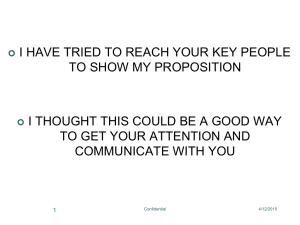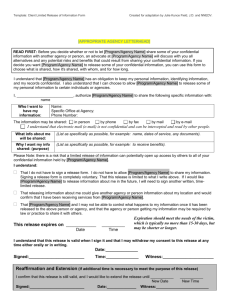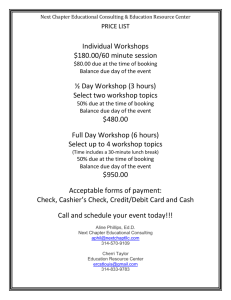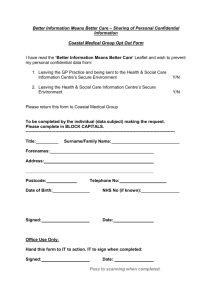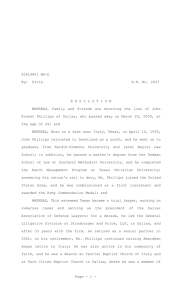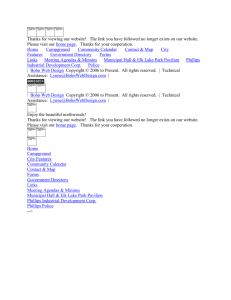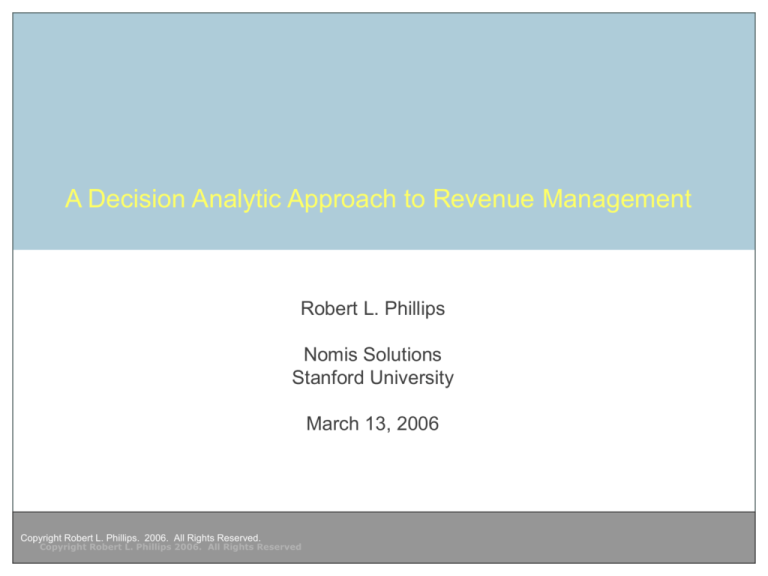
A Decision Analytic Approach to Revenue Management
Robert L. Phillips
Nomis Solutions
Stanford University
March 13, 2006
Copyright Robert L. Phillips. 2006. All Rights Reserved.
Copyright Robert L. Phillips 2006. All Rights Reserved
Agenda
• Introduction to Revenue Management
• Elements of Revenue Management
• Capacity Control
• Overbooking
• Network Management
• An RM System Example
Copyright Robert L. Phillips. 2006. All Rights Reserved.
Property of Nomis Solutions Inc. - Confidential Material
Page 2
What is Revenue Management?
The allocation of fixed capacity to different customer classes with different fares
in order to maximize profitability.
A special case of Pricing and Revenue Optimization, applicable in situations
with:
• Fixed and perishable capacity (and therefore opportunity costs)
• Advanced bookings
• Fixed fare classes
• Uncertain demand and customer behavior (no-show, cancellation)
Copyright Robert L. Phillips. 2006. All Rights Reserved.
Property of Nomis Solutions Inc. - Confidential Material
Page 3
Basic Revenue Management Business Assumptions
•
Fixed, immediately perishable capacity -- airline seat, hotel room night, gas pipeline capacity, etc.
•
Units of capacity are identical - “a seat is a seat”
•
Reservations (bookings) for future capacity accepted prior to its use
•
Marginal costs per unit sale are fixed and small relative to price per unit
•
A finite number of fixed prices are set ahead of time.
•
The seller can control the number of units that he will provide for sale at each price at each time
before departure.
•
The seller has opportunities to change availabilities at intervals prior to departure based on
bookings received.
•
The goal of the seller is to control availability by fare class in each time before departure in order to
maximize revenue (= contribution)
This is the “basic revenue management” business problem. Each of the assumptions can be
relaxed to create a variation.
Copyright Robert L. Phillips. 2006. All Rights Reserved.
Property of Nomis Solutions Inc. - Confidential Material
Page 4
History of Revenue (Yield) Management
•
Early 60’s - Overbooking Analysis, News-vendor Problem
•
Late 70’s - Airline deregulation
•
1981 - Rise of Peoples Express (Discount Airline)
•
1982 - Adoption of Controlled Super-Saver fares (American Airlines)
•
1983 - 1990 Development of first leg-based Airline Revenue Management Systems by major
airlines. Development of Commercial Revenue Management Systems (Aeronomics, DFI, PROS,
SABRE)
•
1985 - 1990 Development of early hotel (Marriott, Hyatt) Systems. Commercial hotel RM systems
(Aeronomics, DFI, OPUS)
•
1989 First O&D Airline Revenue Management System (SAS)
•
1990 First Rental Car System (Hertz)
•
1990’s E-Commerce, distribution control, lifetime customer value issues
•
1995 - today. Pricing and Revenue Optimization Systems (Talus, Manugistics, Khimetrics,
ProfitLogic, …)
Copyright Robert L. Phillips. 2006. All Rights Reserved.
Property of Nomis Solutions Inc. - Confidential Material
Page 5
Revenue Management Industries
Industry
Passenger Airline
Hotel
Rental Car
Broadcasting
Events
Cruise Line
Concert/Sporting
Event
Air Freight
Capacity
Unit
Seat
Capacity
Types
1-3
Room Night
Rental Day
Time unit
Seat
Berth
Seat
1-5
3 - 10
many
1 - 10
1 - 15
1 - 10
Capacity
Fixed?
Network
Largely
Origin and
Destination
Yes
Length of Stay
No
Length of Rental
Yes
Commerical Block
Yes
None
Yes
None
Yes
None
Weight, Volume
1-3
Largely
Copyright Robert L. Phillips. 2006. All Rights Reserved.
Property of Nomis Solutions Inc. - Confidential Material
Page 6
Origin and
Destination
The Basic Revenue Management Question
A supplier (airline, hotel, made-to-order manufacturer) takes reservation for
some stock of fixed capacity.
A customer is “on the phone” requesting a particular fare. Do we say “yes” and
sell him at the requested fare or do we say “no”?
Why we would say yes:
• To get his revenue
Why we might say no:
• Because we don't have sufficient capacity to accommodate him
• Because he might displace a future, more profitable booking
Copyright Robert L. Phillips. 2006. All Rights Reserved.
Property of Nomis Solutions Inc. - Confidential Material
Page 7
Revenue Management Elements
•
Capacity Control: How to allocate limited capacity to different classes of
customer?
•
Overbooking: How many total bookings to accept?
•
Network Management: How to manage bookings across a complex service
network?
•
Additional Topics: Customer value management; group management;
integration with pricing, scheduling, etc
We will discuss capacity control, overbooking, and network management.
Copyright Robert L. Phillips. 2006. All Rights Reserved.
Property of Nomis Solutions Inc. - Confidential Material
Page 8
Agenda
• Introduction to Revenue Management
• Elements of Revenue Management
• Capacity Control
• Overbooking
• Network Management
• An RM System Example
Copyright Robert L. Phillips. 2006. All Rights Reserved.
Property of Nomis Solutions Inc. - Confidential Material
Page 9
Basic Airline Segmentation
Leisure Travelers
•Price Sensitive
•Book Early
•Schedule Insensitive
fd = Discount Fare
Copyright Robert L. Phillips. 2006. All Rights Reserved.
Page 10 Property of Nomis Solutions Inc. - Confidential Material
Business Travelers
•Price Insensitive
•Book Later
•Schedule Sensitive
ff = Full fare
Two-Class Capacity Management Problem
•
Fixed capacity C
•
Two fare classes (full-fare and discount) with fares ff > fd > 0. Marginal costs are 0.
•
Discount fares book first. All seats not sold at discount are available for sale at full
fare.
•
No cancellations or no-shows.
•
The demands at each fare are random variables, dd and df..
•
Ff (x) = Probability that df < x.
How many seats should we save for late-booking full-fare customers?
Copyright Robert L. Phillips. 2006. All Rights Reserved.
Page 11 Property of Nomis Solutions Inc. - Confidential Material
Capacity Control Problem Tradeoffs
•
Cannibalization - Seats were sold at fd, but some full-fare customers were
turned away due to lack of seats. Cost = fd - ff for each full-fare customer
turned away.
•
Spoilage - Discount passengers were turned away but the plane left with
empty seats. Cost = fd for each “spoiled” seat.
How do we set b -- the first period booking limit -- to optimally balance
cannibalization and spoilage and maximize expected total revenue?
Copyright Robert L. Phillips. 2006. All Rights Reserved.
Page 12 Property of Nomis Solutions Inc. - Confidential Material
Capacity Control Problem: Marginal Analysis
Relative
Impact
dd < b
0
Fd(b)
df > C - b
b b+1
1- Ff(C-b)
1-Fd(b)
fd - ff
dd > b
Ff(C-b)
Hold b Constant
Copyright Robert L. Phillips. 2006. All Rights Reserved.
Page 13 Property of Nomis Solutions Inc. - Confidential Material
df < C - b
fd
0
Optimality Condition for Two-Class Problem
The optimal booking limit b* solves Ff(C-b*) = 1 - fd/ff . This is
known as Littlewood’s Rule.
Littlewood's Rule is a simple variation on the standard critical
fractile solution to the newsvendor problem.
Copyright Robert L. Phillips. 2006. All Rights Reserved.
Page 14 Property of Nomis Solutions Inc. - Confidential Material
Two ways to implement Littlewood's rule
•
Set booking limit b* and hold
•
Use Littlewood's rule as the basis a dynamic decision rule:
Accept discount bookings as long as fd > [1-Ff(C-xd)]ff, where xd is the
number of discount bookings already accepted.
Copyright Robert L. Phillips. 2006. All Rights Reserved.
Page 15 Property of Nomis Solutions Inc. - Confidential Material
Interpreting Littlewood's Rule
Acceptance Criterion: fd
>
[1-Ff(C-xd)]ff
This is expected opportunity cost!
1
Expected
Opportunity Cost
$
fd
0
0
10
Accepted Bookings
Copyright Robert L. Phillips. 2006. All Rights Reserved.
Page 16 Property of Nomis Solutions Inc. - Confidential Material
Net revenue as a function of booking limit
$15,000
Revenue
$14,000
$13,000
Expected DB
Cost
$12,000
Expected
Net Revenue
$11,000
$10,000
$9,000
100
105
110
Booking Limit (b)
Copyright Robert L. Phillips. 2006. All Rights Reserved.
Page 17 Property of Nomis Solutions Inc. - Confidential Material
115
120
Standard Structure for Multi-Class Problem
First
Booking
Period:
Departure
…
n
n-1
3
2
1
Fare:
fn
fn-1
f3
f2
f1
Bookings:
xn
xn-1
x3
x2
x1
Low Fare Bookings
High Fare Bookings
The basic assumption -- bookings occur in order of fare, that is: low to high.
Copyright Robert L. Phillips. 2006. All Rights Reserved.
Page 18 Property of Nomis Solutions Inc. - Confidential Material
Time
Nesting -- a Three-Class Example
x2 = seats reserved for 2 and 3
x1 = seats reserved for 3
Aircraft Seating Capacity
b1 = Booking
Limit for 1
b2 = Booking Limit for 2
We assume three classes 1,2, and 3, booking in order,
with f1 < f 2 < f3
Copyright Robert L. Phillips. 2006. All Rights Reserved.
Page 19 Property of Nomis Solutions Inc. - Confidential Material
Capacity Control with three fare classes
Relative
Impact
d3 < b3
0
F3(b3)
Displace Class 1 Booking
b3 b3+1
p3 – p1
q1
1-F3(b3)
Displace Class 2 Booking
dd > b3
q2
p3 – p2
1-q1-q2
No Displacement
Hold b3 Constant
Copyright Robert L. Phillips. 2006. All Rights Reserved.
Page 20 Property of Nomis Solutions Inc. - Confidential Material
p3
0
Solving the multi-class problem
•
In general, the capacity allocation problem with more than two classes does
not have a closed-form solution.
•
Two solution alternatives:
•
•
Solve by dynamic programming -- generally too computationally intensive.
EMSR heuristics -- formulate as a series of two-class problems and approximate
the solution.
Copyright Robert L. Phillips. 2006. All Rights Reserved.
Page 21 Property of Nomis Solutions Inc. - Confidential Material
Agenda
• Introduction to Revenue Management
• Elements of Revenue Management
• Capacity Control
• Overbooking
• Network Management
• An RM System Example
Copyright Robert L. Phillips. 2006. All Rights Reserved.
Page 22 Property of Nomis Solutions Inc. - Confidential Material
Overbooking
Airlines and other industries historically allowed passengers to cancel or noshow without penalty. Airlines book more passengers than their capacity in
order to hedge against this uncovered call, Airlines need to balance two
risks when overbooking:
Spoilage: Seats leave empty when a booking request was received. Lose a
potential fare.
Denied Boarding Risk: Accepting an additional booking leads to an additional
denied-boarding.
Copyright Robert L. Phillips. 2006. All Rights Reserved.
Page 23 Property of Nomis Solutions Inc. - Confidential Material
Denied Boarding Cost
Consists of four elements:
1. Provision Cost of meals or lodging provided
2. Reaccom Cost of putting a bumped passenger on another flight
3. Direct Cost of direct compensation to the passenger -- usually a
discount certificate for future travel
4. Ill-will Cost for involuntary denied boarding.
Voluntary denied boardings have a higher cost than involuntary denied
boardings.
Copyright Robert L. Phillips. 2006. All Rights Reserved.
Page 24 Property of Nomis Solutions Inc. - Confidential Material
Denied Boarding Rates
1993
1997
2000
Voluntary
15
21
20
Involuntary
1
1
1
Total
16
22
21
Denied Boarding Rates per 100,000 Boardings
Source: US DOT. Large US domestic Carriers
Copyright Robert L. Phillips. 2006. All Rights Reserved.
Page 25 Property of Nomis Solutions Inc. - Confidential Material
Marginal Analysis: Overbooking
Relative
Impact
s does not increase
(1-p)
(s|b) > C
D>b
F(b)
0
f-d
p
s s+1
b b+1
(s|b) < C
D<b
Copyright Robert L. Phillips. 2006. All Rights Reserved.
Page 26 Property of Nomis Solutions Inc. - Confidential Material
f
0
Overbooking Problem Solution
We want to find the smallest b* such that:
F(b*)p[Pr{(s|b*)>C}(f-d) + Pr{(s|b*)<C}f] = 0
or:
Pr{(s|b*) > C}(f-d) +[1- Pr{(s|b*) > C}]f = 0
Pr{(s|b*) > C} = f/d
Copyright Robert L. Phillips. 2006. All Rights Reserved.
Page 27 Property of Nomis Solutions Inc. - Confidential Material
Overbooking Revenue
C
Revenue
$11,000
b*
Passenger
Revenue
$10,000
Overbooking
Cost
$9,000
Net
Revenue
$8,000
90
100
Booking Limit
Copyright Robert L. Phillips. 2006. All Rights Reserved.
Page 28 Property of Nomis Solutions Inc. - Confidential Material
110
120
Overbooking Dynamics
Bookings
Booking Limit
No-show
“Pad”
Capacity
Bookings
A
Copyright Robert L. Phillips. 2006. All Rights Reserved.
Page 29 Property of Nomis Solutions Inc. - Confidential Material
B
Departure
Time
Agenda
• Introduction to Revenue Management
• Elements of Revenue Management
• Capacity Control
• Overbooking
• Network Management
• An RM System Example
Copyright Robert L. Phillips. 2006. All Rights Reserved.
Page 30 Property of Nomis Solutions Inc. - Confidential Material
Copyright Robert L. Phillips. 2006. All Rights Reserved.
Page 31 Property of Nomis Solutions Inc. - Confidential Material
Hotel Network
...
Resources: Monday
Products:
Tuesday
Wednesday
Thursday
Friday
Friday 1-Night
Monday 3-Night Stay
Tuesday 2-Night Stay
Wednesday 3-Night Stay
...
Copyright Robert L. Phillips. 2006. All Rights Reserved.
Page 32 Property of Nomis Solutions Inc. - Confidential Material
Passenger Train Capacity and Load
July 2002
9,000
Final Bookings
8,000
7,000
6,000
5,000
4,000
3,000
2,000
1,000
Riders Aboard
Copyright Robert L. Phillips. 2006. All Rights Reserved.
Page 33 Property of Nomis Solutions Inc. - Confidential Material
Total Seats
CHI
OMA
DEN
GSC
SLC
RNO
SAC
SFO
0
Hotel Example
Unconstrained
Occupancy
Capacity
Su
M
T
W
Day of Week
Copyright Robert L. Phillips. 2006. All Rights Reserved.
Page 34 Property of Nomis Solutions Inc. - Confidential Material
Th
F
Sa
Why the Problem is Hard
Flight 1
San Francisco
(SFO)
Flight 2
Denver
(DIA)
St. Louis
(STL)
SFO – STL Fare = $400
SFO – DIA Fare = $200
DIA – STL Fare = $250
Which passengers we want to accept depends upon expected
demands for all products. Sometimes we prefer SFO-STL pax,
sometimes we prefer SFO-DIA or DIA-STL pax.
Copyright Robert L. Phillips. 2006. All Rights Reserved.
Page 35 Property of Nomis Solutions Inc. - Confidential Material
When the Problem Really gets Interesting...
Flight 1
San Francisco
(SFO)
Market
Flight 2
Denver
(DIA)
St. Louis
(STL)
Y-Class
M-Class
B-Class
G-Class
SFO-STL
$600
$400
$300
$250
SFO-DIA
$280
$200
$150
$140
DIA-STL
$350
$250
$180
$110
Copyright Robert L. Phillips. 2006. All Rights Reserved.
Page 36 Property of Nomis Solutions Inc. - Confidential Material
Bid Pricing
Set a bid price equal to the opportunity cost (λ) on each leg.
Flight 1
Flight 2
BP = $230
BP = $190
San Francisco
(SFO)
Market
Denver
(DIA)
St. Louis
(STL)
Y-Class
M-Class
B-Class
G-Class
SFO-STL
$600
$400
$350
$250
SFO-DIA
$280
$200
$150
$140
DIA-STL
$350
$250
$180
$110
Copyright Robert L. Phillips. 2006. All Rights Reserved.
Page 37 Property of Nomis Solutions Inc. - Confidential Material
Hotel Bid Price Calendar
Mon
31
Tue
1
Wed
2
Thur
3
Fri
4
Sat
5
Sun
6
d=85
d=93
d=112
d=108
d=99
d=65
d=80
b=$84.34
b=$92.07
b=$153.12
b=$112.34
b=$92.57
b=$54.30
b=$62.33
7
8
9
10
11
12
13
d=91
d=102
d=135
d=120
d=92
d=53
d=44
b=$88.47
b=$122.00
b=$172.15
b=$142.34
b=$95.67
b=$42.34
b=32.34
14
15
16
17
18
19
20
d=67
d=85
d=110
d=97
d=93
d=72
d=66
b=$54.37
b=$72.48
b=$122.47
b=$99.97
b=$92.34
b=$55.18
b=$54.54
21
22
23
24
25
26
27
d=86
d=104
d=157
d=140
d=122
d=95
d=85
b=$89.11
b=$130.02
b=$199.93
b=$178.25
b=$122.20
b=100.69
b=$85.18
28
29
30
31
1
2
3
d=84
d=92
d=114
d=100
d=82
d=60
d=75
b=$84.33
b=$93.44
b=$155.67
b=$101.01
b=$78.77
b=$53.92
b=$62.74
Copyright Robert L. Phillips. 2006. All Rights Reserved.
Page 38 Property of Nomis Solutions Inc. - Confidential Material
Agenda
• Introduction to Revenue Management
• Elements of Revenue Management
• Capacity Control
• Overbooking
• Network Management
• An RM System Example
Copyright Robert L. Phillips. 2006. All Rights Reserved.
Page 39 Property of Nomis Solutions Inc. - Confidential Material
Sporting Event Revenue Management
A classic Revenue Management opportunity:
•
Fixed, immediately perishable inventory
•
Seating sections in stadiums are similar to cabins in airplanes
•
Section prices are fixed prior to season starting
•
Season tickets are offered first; all other seats are free-sell
•
Bookings come in over time…from a year out to the day of the game
•
Most baseball teams have a range of discounts that apply to a seating sections market segments
• Jnr, Snr, 4H, buy-one-get-one-free
Copyright Robert L. Phillips. 2006. All Rights Reserved.
Page 40 Property of Nomis Solutions Inc. - Confidential Material
EventRM – Challenges
•
Industry resistant to change -
•
Very risk averse -- like quick sell-outs (especially concerts)
•
Fear public perception of venue trying to “gouge” the fans with higher
prices -- want to increase revenue without increasing price
•
Bookings do not follow traditional industry approach of lowest value
books first, highest value books last
• value of ticket is not correlated to time of booking
•
Availability denials not currently captured
•
Data can be sparse
Copyright Robert L. Phillips. 2006. All Rights Reserved.
Page 41 Property of Nomis Solutions Inc. - Confidential Material
EventRM – What it Does
•
Forecasts demand for each market segment
• historical data enables market segmentation
•
Maximizes expected revenue from forecasted remaining demand into
remaining capacity
•
Recommends which market segments to sell to
• venue sets rate structure for market segments
• event manager determines which market segments are always open
• event manager has final say on which segments to keep open for
sale or to close
•
DOES NOT recommend changes in price
Copyright Robert L. Phillips. 2006. All Rights Reserved.
Page 42 Property of Nomis Solutions Inc. - Confidential Material
Event Overview
Copyright Robert L. Phillips. 2006. All Rights Reserved.
Page 43 Property of Nomis Solutions Inc. - Confidential Material
Pricing Screen
Copyright Robert L. Phillips. 2006. All Rights Reserved.
Page 44 Property of Nomis Solutions Inc. - Confidential Material
Booking Pace
Copyright Robert L. Phillips. 2006. All Rights Reserved.
Page 45 Property of Nomis Solutions Inc. - Confidential Material
Demand Forecast
Copyright Robert L. Phillips. 2006. All Rights Reserved.
Page 46 Property of Nomis Solutions Inc. - Confidential Material
Optimization Parameters
Copyright Robert L. Phillips. 2006. All Rights Reserved.
Page 47 Property of Nomis Solutions Inc. - Confidential Material
Re-Optimize
Copyright Robert L. Phillips. 2006. All Rights Reserved.
Page 48 Property of Nomis Solutions Inc. - Confidential Material
Optimization
Copyright Robert L. Phillips. 2006. All Rights Reserved.
Page 49 Property of Nomis Solutions Inc. - Confidential Material
Availability Controls
Copyright Robert L. Phillips. 2006. All Rights Reserved.
Page 50 Property of Nomis Solutions Inc. - Confidential Material
Summary
•
Revenue management is the science of setting availabilities for multiple fare
classes in the case in which capacity is constrained and perishable.
•
The decision analytic approach gives lots of insight and some useable
answers to basic revenue management problems without lots of annoying
multiple integrals!
•
Many dynamic revenue management implementations involve calculating
the opportunity cost of a unit of remaining capacity and accepting only those
requests whose fare exceeds the opportunity cost.
Copyright Robert L. Phillips. 2006. All Rights Reserved.
Page 51 Property of Nomis Solutions Inc. - Confidential Material

